The Iranian government’s internet policies have increasingly created a class-based digital system, where access is determined by income. These policies have stalled network development and caused intentional disruptions to people’s daily lives, particularly during the New Year holidays.
Over the past month, these developments in network policies have significantly impacted user access to online services. These effects are expected to continue in the coming months:
IranAccess in the Banking Network Disrupts Daily Life
The restriction of access to banking networks under the IranAccess system has significantly disrupted everyday life in Iran. With the Persian New Year (Nowruz) approaching, the impact has been especially severe;hindering e-government services, tax and accounting procedures, holiday shopping, and the livelihoods of those working in internet and banking-related sectors.
Meanwhile security and economic pressure on startups continues, prompting founders to exit their ventures. This trend has allowed government-affiliated institutions to gain low-cost, high-speed access to users’ everyday data—on a scale previously unseen.
The government, under the pretext of solving electricity problems, has also initiated the digitization of the power grid, which grants further access to online user data and enhances the state’s ability to suppress dissent digitally.
Against this backdrop, the government’s monopolistic policies around internet access have increasingly turned it into a luxury commodity inaccessible to many social classes. This issue is evident in government reports published in Winter 2025. Continued enforcement of such policies will lead to lower quality internet access for the public, the exit of investors from the telecom and internet market, and a shift of users toward censored domestic networks.
IranAccess During New Year: Daily Life Paralyzed
IranAccess applied to payment gateways—initially justified in October 2024 as a national security measure to prevent cyberattacks—has now directly affected ordinary users. With Nowruz approaching, these disruptions may indirectly affect a wider portion of the population, even those not typically online.
Filterwatch’s investigations reveal that due to outdated banking IP databases, non-banking IPs have also been restricted under IranAccess since autumn 2024. This means not only banking services but other service apps have experienced outages as well.
With the financial year-end near, and the need to close accounting, tax, and insurance files, the next month will see high volumes of network traffic and online banking use. Due to inflation and the difficulty of carrying cash, most purchases in Iran—large and small—are done via card readers. These disruptions will directly impact holiday shopping during March 2025. If the situation continues, dissatisfaction with both government and internet services will rise.
Filterwatch estimates that this will put additional pressure on banks and related online service providers. These companies may need to hire new staff to manage customer complaints, increasing their overhead costs.
Private Capital Exiting the Digital Market
The government’s monopolistic tendencies and appetite to dominate the startup ecosystem have driven major shareholders—such as in the “ASAN PARDAKHT” startup—to exit the market last month. The withdrawal of capital, which intensified in early 2024, has shrunk the private startup space in Iran and expanded the influence of semi-private (government-affiliated) and state-owned companies.
This shift allows government bodies quicker access to daily user data without needing security or judicial intermediaries. Real-time access to this data aids in strengthening the government’s “Lifestyle System” software and cracking down on dissent. Considering the poor digital security record of state and semi-private companies in recent years, user data in newly acquired startups is now more vulnerable to hacking.
Controlling Data Under the Pretext of Power Management
While misguided energy policies have pushed citizens toward crypto mining and digital currencies, the government blames miners for power outages and connectivity issues. Simultaneously, it has restricted crypto payment gateways, pressuring operators to share customer data.
The Ministry of ICT has launched a smart metering project, promising to fix power issues. These data sets are expected to feed into the Lifestyle System database,an essential tool for suppressing dissent swiftly and at low cost during protests.
Shrinking Internet Market and Class-Based Access
Due to rising access costs—caused by policies separating domestic and international traffic—and increased outages since the “Woman, Life, Freedom” movement, internet access has increasingly become a luxury. This, combined with reduced tech/startup investment and the departure of major investors, will further shrink Iran’s internet market.
According to Iran’s telecom regulatory report, revenue and investment in the telecom sector are declining. Despite rising inflation and currency devaluation, fiber-optic household coverage has not improved, and high-speed internet coverage remains stagnant.
Parliament’s Research Center reports that 80% of Iranian users rely on VPNs for unrestricted internet access, 30% of whom pay for premium VPN services. Despite higher user costs, these funds are not reinvested in infrastructure, essentially removing them from the national development budget. As a result, rising tariffs only decrease user consumption.
However, given the increasing use of VPNs and the higher engagement with blocked social networks over domestic platforms, the government’s strategy to drive users to local apps appears to have failed.
Put simply, the internet has become too expensive to use, leading to decreased consumption. Long-term consequences include reduced global engagement and user migration to censored domestic networks. In events like the November 2019 protests, this gives the authorities more freedom to suppress and disconnect the internet.
Though projects like Starlink have offered unrestricted access—albeit costly—the public’s struggle for internet freedom continues to come at a high price.
Disruption During Tehran University Dormitory Protests
On February 15, during a protest by students in response to the killing of a student by muggers near the University of Tehran dormitory, IODA’s graph of AS58224 showed disruptions starting at 11:30 p.m., lasting at least 90 minutes. Filterwatch cannot independently confirm whether the disruption was linked to the protests.

Disruption During Power Outage Protests in Dehdasht
According to Filterwatch, mobile internet access via Iran’s two main operators—Hamrah-e Aval and Irancell—was severely disrupted in Dehdasht, Kohkiluyeh and Boyer-Ahmad Province. This occurred alongside protests against power outages and economic conditions.
The outage, which was not visible in global monitoring systems like IODA or Cloudflare, was likely localized, potentially caused by switching off mobile antennas or using the SIAAM system—something with previous precedent. Filterwatch reports the disruption continued into the following day.
Snap Service Disruption Due to Data Center Outage
On February 26, Filterwatch sources confirmed that services for Snap, a major super-app in Iran, were disrupted for at least 90 minutes due to issues at ArvanCloud, Iran’s largest cloud services provider.
Recurring Daily Disruptions
Ayuda data shows that from February 2 to February 26, internet services from Shatel, Irancell, and TCI experienced minor BGP routing disruptions between 2:30 a.m. and around 10 a.m. daily. Although these ISPs serve a large user base, the limited scope and off-peak timing of the disruptions meant users mainly experienced slower speeds.

